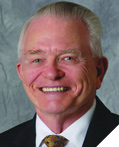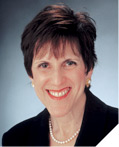Annual Report 2014
Officer's Message
A Year of Change and Growth

Tom Barton
President

William F. Carroll, Jr.
Chair,
Board of Directors

Madeleine Jacobs
Executive Director
& CEO
2014—it was a year of solid achievement for the American Chemical Society (ACS). ACS members, governance, and staff, often working with other organizations, fulfilled the vision and mission of ACS. The 2014 ACS Annual Report highlights many of these accomplishments and diverse initiatives that serve our members and the broader scientific enterprise worldwide. You can see the 2014 Highlights of ACS Achievements.
ACS President Tom Barton focused on four areas during his presidential year: education, energy, environment, and improving the public image of chemistry. He was an advocate for the progress and growth of the chemistry enterprise. Barton sponsored Presidential Symposia highlighting these topics during the ACS national meetings in Dallas and San Francisco.
It was a year that saw the ACS solidify itself as the most authoritative, comprehensive, and indispensable provider of chemistry-related information. ACS Publications published more than 41,000 articles across its portfolio of 44 peer-reviewed journals.
ACS journals continued their preeminence in citations and Impact Factors while continuing to develop new and enhanced content and delivery systems. ACS journals are available worldwide in online and mobile formats, as well as in print. The 2013 Journal Citation Reports® were released by Thomson Reuters in June 2014. ACS journals continued to perform extremely well, receiving more than 2.4 million total annual citations and ranking #1 in citations in each of the seven core chemistry categories.
The ACS Publications division also launched an ambitious open access publishing strategy. The program debuted on New Years’ Day with the selection of the first ACS Editors’ Choice article. Each day, a new noteworthy ACS Editors’ Choice article from one of our peer-reviewed publications was made openly accessible. Articles from every journal were featured during 2014, drawing more than 600,000 page views.
Chemical & Engineering News (C&EN) – the Society’s flagship news periodical covering the global chemistry enterprise and related sciences -- made important changes to both its editorial and advertising sales operations in 2014. In December, C&EN welcomed Bibiana Campos-Seijo as the magazine’s new Editor-in-Chief. Campos-Seijo previously served as Editor and Publisher of Chemistry World in the UK.
In September, the magazine sponsored its inaugural “virtual symposium.” This one-day symposium, produced in partnership with BioConference Live, focused on “Advances in Drug Discovery & Development.” It featured 20 leading scientist speakers, and attracted more than 7,300 individual registrations.
In addition, C&EN recently established an agreement with Scientific American, whereby that popular science magazine now regularly features a selection of C&EN stories within the Chemistry section of its website.
The Society’s Chemical Abstracts Service (CAS) remains the world's authority for chemical information and related solutions and the CAS REGISTRYSM is the world’s largest collection of chemical substance information.
Consistent with past performance, CAS databases experienced robust growth, with more than 1.5 million patents, journal articles and other disclosed research sources added, for a new total of more than 40 million records available in the CAplusSM database. Updated daily, CAS added more than 1.4 million new single-step reactions to CASREACT®, with more than 77 million single- and multi-step reactions, plus synthetic preparations now available to researchers.
Because of the work of the more than 1,000 scientists around the world who assemble, curate, and assure the quality of the CAS databases, researchers can efficiently and reliably explore the largest collection of disclosed chemical synthesis information from 1840 to the present.
Our two national meetings – in Dallas and San Francisco -- attracted a combined total of more than 22,000 papers and 30,000 participants. ACS also held five regional meetings in 2014, drawing more than 3,000 papers and a combined attendance of nearly 5,000.
In early 2014, the Society also launched ACS Career Navigator. This new integrated program seamlessly combines the offerings of ACS Career Services, Professional Education, Leadership Development, and Market Intelligence to more effectively meet the professional needs of members and potential members at all of their varied career stages.
In an effort to help local sections and student chapters host events and easily create local networking opportunities, the Society introduced ACS Program-in-a-Box. Using this innovative approach, speakers are made available to ACS groups via YouTube and GoToMeeting and the sections and chapters arrange events around those virtual presentations. When groups sign up to participate they also receive a box of related promotional materials, handouts and prizes to share with their members at the event. In 2014 more than 200 student chapters and local sections participated (including 11 international sites), and attracted more than 4,000 members or potential members. ACS Program-in-a-Box received a financial sponsorship from Procter & Gamble, and will partner with the ACS Younger Chemists Committee to produce two events in 2015.
In 2014, as part of its continuing commitment to education, ACS launched the American Association of Chemistry Teachers (AACT), the first organization of its kind in the U.S. It provides K-12 teachers of chemistry with a professional home and access to specialized resources and the broader ACS community. The creation of AACT is an important milestone in ACS’s ongoing work to expand the Society’s support for K-12 chemistry teachers, who prepare the chemists—and ACS members—of tomorrow.
Of course, in order to support these and other efforts, ACS must be a financially sustainable organization. With that in mind, we are pleased to announce that for the 11th consecutive year, ACS ended the year with a positive net contribution from operations. You can review the Society’s financial statements here.
One last note -- in 2014 Madeleine Jacobs, ACS Executive Director & Chief Executive Officer, announced to the ACS Board of Directors that she would retire in February 2015. After 24 years of stellar service to ACS and the chemistry enterprise, Jacobs will leave ACS with many honors and accomplishments—and friends throughout the world! The Board, after an extensive search, selected Dr. Thomas M. Connelly, Jr. as the next ACS Executive Director & Chief Executive Officer. Dr. Connelly, most recently Executive Vice President and Chief Innovation Officer for DuPont, will join ACS in mid-February 2015.
As we look forward to 2015, ACS will remain true to its vision and mission. ACS will continue to be a catalyst for possibility and progress. And above all, ACS will remain the focal point for chemical professionals around the world to meet, share information, and find tools and guidance that enable them to become stronger and more marketable scientists.
